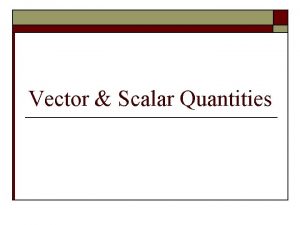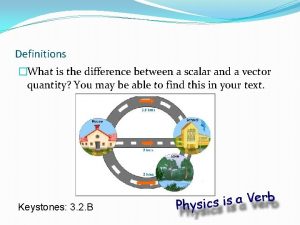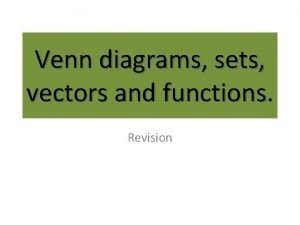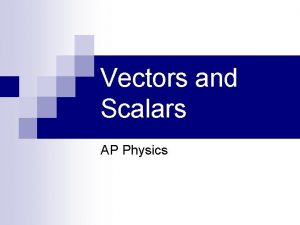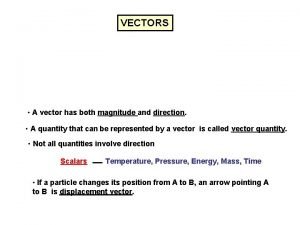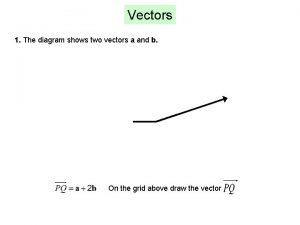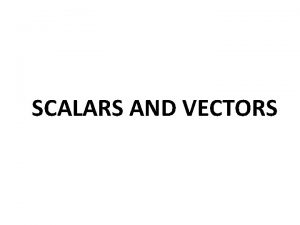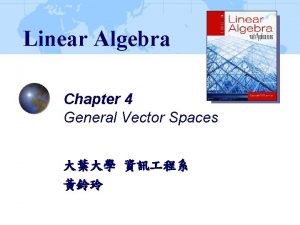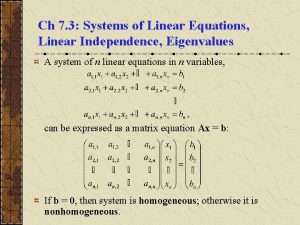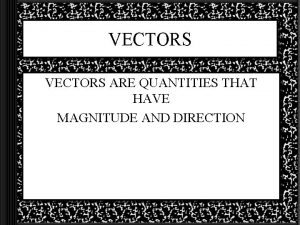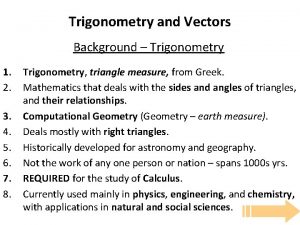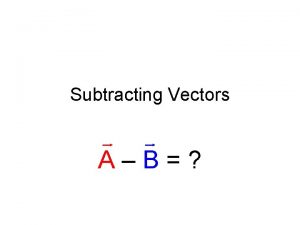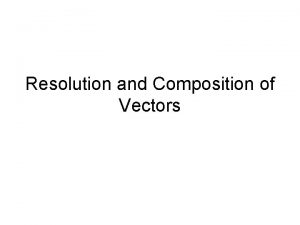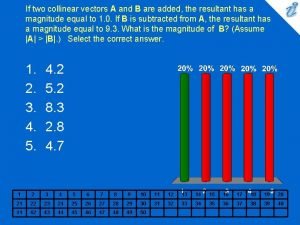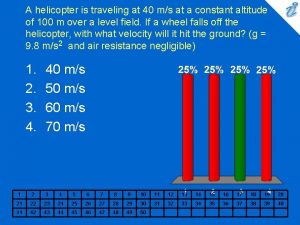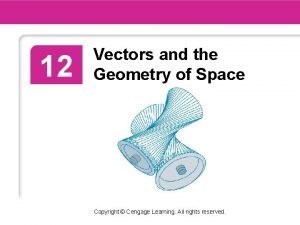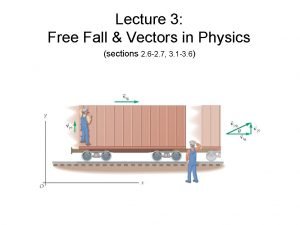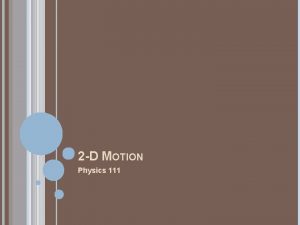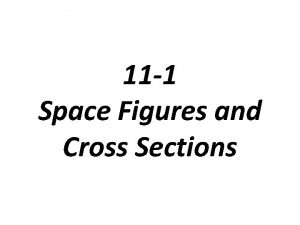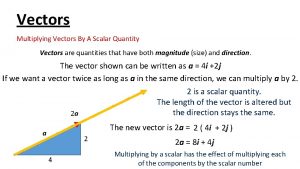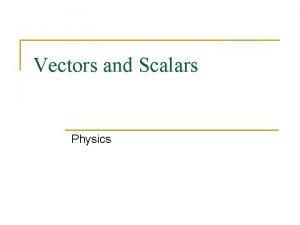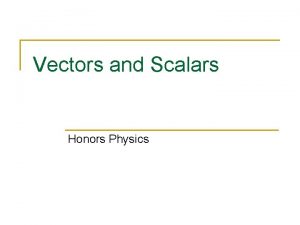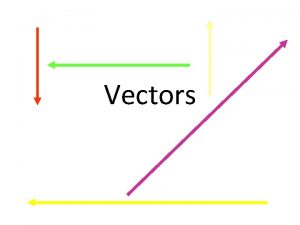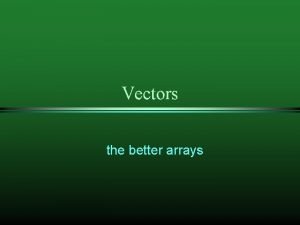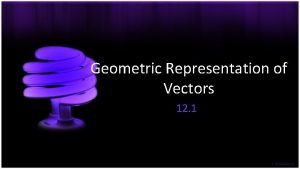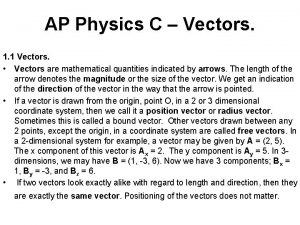Vectors Sections 3 1 and 3 2 scalar
















































- Slides: 48

Vectors Sections 3. 1 and 3. 2

scalar a physical quantity that has magnitude but no direction

scalar a physical quantity that has magnitude but no direction

A resultant vector represents the sum of two or more vectors.

When adding vectors, you must make certain that they have the same units and describe similar quantities.

Vectors can be added graphically.


Properties of Vectors can be moved parallel to themselves in a diagram.

Vectors can be added in any order.

To subtract a vector, add its opposite.

Multiplying or dividing vectors by scalars results in vectors.






Section 3. 2 There are no firm rules for applying coordinate systems to situations involving vectors. As long as you are consistent, the final answer will be correct regardless of the system you choose. Perhaps your best choice for orienting axes is the approach that makes solving the problem easiest for you.

Two Different Coordinate Systems A plane traveling northeast at a velocity of 300 m/s can be represented as either (a) moving along a y-axis chosen to point to the northeast or (b) moving at an angle of 45° to both the x and y-axes, which line up with west-east and south-north, respectively.


Determining Resultant Magnitude and Direction When the vectors you are combining are perpendicular, use the Pythagorean theorem to find the magnitude of the resultant.




Use the tangent function to find the direction of the resultant.







Resolving Vectors into Components components of a vector the projections of a vector along the axes of a coordinate system

Any vector can be completely described by a set of perpendicular components. The x component is parallel to the x-axis. The y component is parallel to the y-axis.

Components of vectors are shown as outlined, open arrows. Components have arrowheads to indicate their direction. Components are scalars (numbers), but they are signed numbers. The direction is important to determine their sign in a coordinate system.

You can often describe an object’s motion more conveniently by breaking a single vector into two components, or resolving the vector. Resolving a vector allows you to analyze the motion in each direction.

The sine and cosine functions are defined in terms of the lengths of the sides of such right triangles.

The sine of an angle is the ratio of the leg opposite that angle to the hypotenuse.

The cosine of an angle is the ratio between the leg adjacent to that angle and the hypotenuse.






Adding Vectors That Are Not Perpendicular





 Scalar product of vectors
Scalar product of vectors Tell something about the multimodal text big ed mona
Tell something about the multimodal text big ed mona Vector components formula
Vector components formula Distinguish between scalar and vector
Distinguish between scalar and vector Scalar quantity and vector quantity
Scalar quantity and vector quantity Scalar vs vector projection
Scalar vs vector projection Scalar quantities have size or magnitude only
Scalar quantities have size or magnitude only Dot product
Dot product Find the scalar and vector projections of b onto a
Find the scalar and vector projections of b onto a 50 examples of scalar and vector quantities
50 examples of scalar and vector quantities Scalar and vector quantity difference
Scalar and vector quantity difference Scalar quantity and vector quantity
Scalar quantity and vector quantity Scalar and vector quantization
Scalar and vector quantization A-b venn diagram example
A-b venn diagram example Matrix multiplied by its transpose
Matrix multiplied by its transpose Properties of vector
Properties of vector Vectors and scalars in physics
Vectors and scalars in physics What are i and j in vectors
What are i and j in vectors A vector has both direction and
A vector has both direction and The diagram shows two vectors x and y
The diagram shows two vectors x and y Two dimensional motion and vectors
Two dimensional motion and vectors Entropy is scalar or vector
Entropy is scalar or vector General vector spaces
General vector spaces Linearly dependent and independent vectors
Linearly dependent and independent vectors Vectors and the geometry of space
Vectors and the geometry of space What is linear dependence and independence
What is linear dependence and independence Lesson plan on vectors and scalars
Lesson plan on vectors and scalars Chapter 12 vectors and the geometry of space
Chapter 12 vectors and the geometry of space Properties of a vector
Properties of a vector Vectors trigonometry
Vectors trigonometry The diagram shows two vectors that point west and north.
The diagram shows two vectors that point west and north. Composition of vectors
Composition of vectors Vectors and matrices
Vectors and matrices What are collinear vectors
What are collinear vectors Dot product
Dot product Physical quantities of vectors
Physical quantities of vectors Units, physical quantities, and vectors
Units, physical quantities, and vectors Magnitude of unit vector formula
Magnitude of unit vector formula A student adds two vectors with magnitudes of 200 and 40
A student adds two vectors with magnitudes of 200 and 40 Scalar triple product properties
Scalar triple product properties Dot product
Dot product Define instantaneous acceleration
Define instantaneous acceleration You are adding vectors of length 20 and 40 units
You are adding vectors of length 20 and 40 units Cutaways and cross sections definition
Cutaways and cross sections definition Parietal vs visceral
Parietal vs visceral Superior inferior
Superior inferior Chapter 9 conic sections and analytic geometry
Chapter 9 conic sections and analytic geometry 11.1 space figures and cross sections
11.1 space figures and cross sections Health and safety at work act 1974 sections
Health and safety at work act 1974 sections









